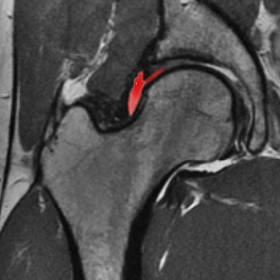Prevalence of Femoroacetabular Impingement Imaging Findings in Asymptomatic Volunteers: A Systematic Review

PainSci notes on Frank 2015:
Structural abnormalities in the hip joint are extremely common in people who have no symptoms at all. This review of x-rays and MRIs of more than 2000 painless hip joints found that 37% had cam deformities, 67% had pincer deformities, and 68% had labral injuries. (Cam and pincer deformities are two different kinds of pinching at the edge of the hip joint, and labral injuries are lesions of the cartilaginous lip of the socket.)
original abstract †Abstracts here may not perfectly match originals, for a variety of technical and practical reasons. Some abstacts are truncated for my purposes here, if they are particularly long-winded and unhelpful. I occasionally add clarifying notes. And I make some minor corrections.
PURPOSE: The aim of this study was to determine the prevalence of radiographic findings suggestive of femoroacetabular impingement (FAI) in asymptomatic individuals.
METHODS: A systematic review was performed using Preferred Reporting Items for Systematic Reviews and Meta-Analyses (PRISMA) guidelines. Studies reporting radiographic, computed tomographic, or magnetic resonance imaging (MRI) findings that were suggestive of FAI in asymptomatic volunteers were included. Cam, pincer, and combined pathologic conditions were investigated.
RESULTS: We identified 26 studies for inclusion, comprising 2,114 asymptomatic hips (57.2% men; 42.8% women). The mean participant age was 25.3 ± 1.5 years. The mean alpha angle in asymptomatic hips was 54.1° ± 5.1°. The prevalence of an asymptomatic cam deformity was 37% (range, 7% to 100% between studies)-54.8% in athletes versus 23.1% in the general population. Of the 17 studies that measured alpha angles, 9 used MRI and 9 used radiography (1 study used both). The mean lateral and anterior center edge angles (CEAs) were 31.2° and 30°, respectively. The prevalence of asymptomatic hips with pincer deformity was 67% (range 61% to 76% between studies). Pincer deformity was poorly defined (4 studies [15%]; focal anterior overcoverage, acetabular retroversion, abnormal CEA or acetabular index, coxa profunda, acetabular protrusio, ischial spine sign, crossover sign, and posterior wall sign). Only 7 studies reported on labral injury, which was found on MRI without intra-articular contrast in 68.1% of hips.
CONCLUSIONS: FAI morphologic features and labral injuries are common in asymptomatic patients. Clinical decision making should carefully analyze the association of patient history and physical examination with radiographic imaging.
LEVEL OF EVIDENCE: Level IV, systematic review if Level II-IV studies.
related content
- Your Back Is Not Out of Alignment — Debunking the obsession with alignment, posture, and other biomechanical bogeymen as major causes of pain
- Pain is Weird — Pain science reveals a volatile, misleading sensation that comes entirely from an overprotective brain, not our tissues
This page is part of the PainScience BIBLIOGRAPHY, which contains plain language summaries of thousands of scientific papers & others sources. It’s like a highly specialized blog. A few highlights:
- Cannabidiol (CBD) products for pain: ineffective, expensive, and with potential harms. Moore 2023 J Pain.
- Inciting events associated with lumbar disc herniation. Suri 2010 Spine J.
- Prediction of an extruded fragment in lumbar disc patients from clinical presentations. Pople 1994 Spine (Phila Pa 1976).
- Characteristics of patients with low back and leg pain seeking treatment in primary care: baseline results from the ATLAS cohort study. Konstantinou 2015 BMC Musculoskelet Disord.
- Effectiveness and cost-effectiveness of universal school-based mindfulness training compared with normal school provision in reducing risk of mental health problems and promoting well-being in adolescence: the MYRIAD cluster randomised controlled trial. Kuyken 2022 Evid Based Ment Health.